Mobile Games Statistics 2024

Page Contents
Mobile Games Statistics: As we explore the history of games, from board games to PC games, it is clear that we find them dominating the platform for mobile. The family classic game of ladders and snakes was once played only in physical format it is now playable on smartphones in a multiplayer mode, which allows siblings to play. The increasing cost of smartphones, combined with their growth as the most popular category of gaming, has made them superior to console and PC gaming. It's now imperative to maintain Mobile Game statistics at regular intervals.
Mobile games were initially commercialized in Japan and later became popular in other regions such as Asia, Europe, North America, and finally all over the world, where smartphones were available. However, it wasn't until Apple launched their app store, that the industry of gaming changed in a radical manner.
Mobile games first became popular in Japan and then became popular in other regions such as Asia, Europe, North America, and finally all over the world, where smartphones were available. However, it wasn't until Apple launched their app store, that the industry of gaming changed in a radical manner.
The main reason behind the huge increase in the rise of mobile gaming. The market worldwide of mobile games is projected to reach $94.8 billion by 2022 (all ahead of $52.7 billion in the year 2018) and is predicted to increase to a value of $139.5 billion in 2026. This is increasing at a rate of 12.3%.
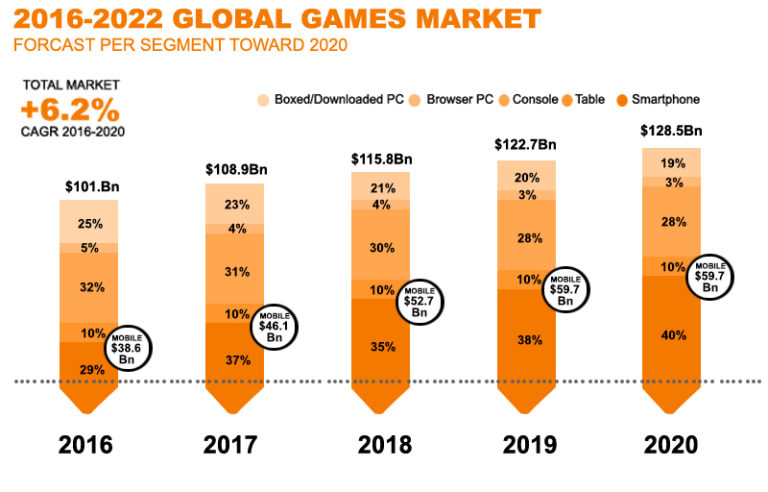 (Source: gameopedia.com)
(Source: gameopedia.com)
History Of Mobile Gaming
The first game ever that was released for a mobile phone came from Tetris on the Hagenuk MT-2000. But mobile games didn't take off before Snake was released in 1997 on phones like the Nokia 6610. It's a game that receives a lot of attention. Technology has evolved and, as it did, so did games.
It is the Wireless Application Protocol (WAP) is a standard for technology that was created for mobile devices that allows them access to the internet. While it was not a huge help to users browsing the internet or playing complicated games, however, fairly simple multiplayer games such as tic-tac-toe and Connect 4 were fun and viable. In the early 2000s, Alien Fish Exchange was among the games that took off.
- However, in 2001 mobile gaming experienced a major moment when the well-known Arcade game Space Invaders, was released on mobile phones.
- Two years after the fact color mobile phones were getting more popular. Thanks to advances in technology, major publishers such as EA have begun making investments in games for mobile. One of the most significant games released during 2004, was Asphalt GT from Gameloft.
- The next major leap forward in mobile gaming began in 2007 when Apple introduced its touchscreen iPhone.
- It was in the month of December, that Rovio Entertainment debuted Angry Birds on the App Store which is a physics-based app that lets you launch animated birds at structures that were filled with pigs who have taken their eggs. This game is inexpensive but addictive and incredibly enjoyable When Rovio brought the game to Android and released the game for free with advertisements, users were able to pay to get rid of them.
- The growth of social media such as Facebook brought games such as Farmville to increase in popularity, having more than 80 million users as of February 2010. Following that was King's launch of Candy Crush Saga in October 2012.
- At the time of the 2013 end, King had seen over 400 million new users join the game. Their revenues increased by $62 million from 2011 to $1.88 billion in advertising revenue or in-app buys.
- The second type of game to gain a large fan base included Clash of Clans. It featured similar in-app purchases to Candy Crush Saga however, it also heavily relied on social engagement, which is similar to that of MMOs. As of October of this year, the game was generating $5.15 million per day and the majority of users have been playing for a long time since its debut, pointing to the multiplayer component that the game offers.
- In 2016 there was a breakthrough technology that came to mobile phones, and revolutionized gaming once again: AR. Games such as Temple Run as well as Subway Surfers used the rudiments of AR technology to provide an extra dimension to their games.
- Pokemon Go had record-breaking numbers of players in its first iOS as well as Android releases attracting more than 100 million players around the world within a month of its launch.
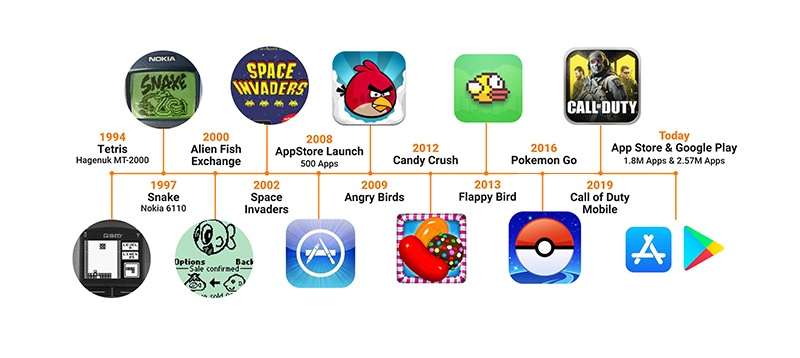
(Source: gameopedia.com)
Stages Of Evolution of Mobile Games
From basic puzzles to enthralling multiplayer games Mobile games have progressed through different stages and each one brings new features and opportunities to players from all over the globe. The following are the various phases of their evolution:
- Stage 1: Dawn Of Mobile Gaming
The beginning of mobile gaming started in the latter part of 1990 and into the early 2000s. In the early 2000s mobile phones were utilized for calling and texting while mobile games were limited to basic arcade games such as Snake as well as Tetris. - Stage 2: Rise of Java Games
The second phase of mobile gaming started in the mid-2000s when Java was introduced as a platform for mobile games. Java games were more sophisticated than the previous versions, featuring better graphics and more efficient gameplay mechanics. They also offered more complicated games, like strategy games, as well as role-playing games (RPGs). - Stage 3: The Rise of the App Store
The third phase of mobile gaming was launched in 2008, with the introduction of the App Store. The App Store lets developers develop and offer their games to millions of iPhone users across the globe. This spawned an entirely new set of games for mobile devices that were specially designed for touchscreen devices. Games such as Angry Birds as well as Fruit Ninja became instant classics with millions of downloads as well as billions in revenues. - Stage 4 The Age of Free-To-Play
The fourth phase of mobile gaming was introduced in the first decade of 2010 when the popularity of free-to-play games. These games were initially dismissed as a cheap way to earn money, however, they soon became the predominant model of business in mobile gaming. Games that are free to play are financed through in-app purchases. Players are able to purchase virtual currency and things to improve their gaming experience. - Phase 5: Rise of AR and VR
The fifth phase in mobile gaming taking place, with the introduction of AR (AR) as well as VR (VR) techniques. AR VR and VR games let players experience virtual worlds in which they interact with characters and digital objects in real time.
Games Market Overview
- The market for games is expected to grow towards 2026: The total amount of players around the world will rise to 3.38 billion by 2023 and will increase by +6.3% year-on-year. Meanwhile, the global market for games will earn revenue in the range of $187.7 billion, which is a year-on-year growth of +2.6%.
- A breakdown of the global game revenues by segment in 2023. Mobile is expected to account for the biggest portion of revenues and console gaming is a key growth engine.
- The top companies in the public sector based on gaming revenues: Tencent, Sony, and Apple are at the top of the list in 2023. The report delves into the companies that are producing the highest game revenue.
- Trends analysis of the use of generative AI for game design. In the comprehensive report, we look at many different developments, including the emergence of game studios run by influencers as well as the most interesting markets. This report offers an insight into one of the favorite trends which is the way artificial intelligence is changing the gaming industry and the development of games.
- A brief overview of how transmedia storytelling impacts game participation and the condition of game viewing in live games.
- It is predicted that the market for gaming in the world will reach 268.8 billion U.S. dollars annually in 2025 which is up from 17 billion U.S. dollars in 2021. North America is set to remain the leading gaming market globally despite a rapid increase in regions like the Asian region. In-game purchases are expected to make up more than 774 million U.S. dollars worldwide in 2025.
- Global Mobile Gaming reach 2022 according to region – Based on the regions selected The ranking according to percent of participation in the “Mobile Games' category of the market for digital media is led by North America with 41.03% and is closely followed by South America (27.39%). However, the position is dominated by Africa with 17.79%, which is an increase in the region of 23.24% points from North America.
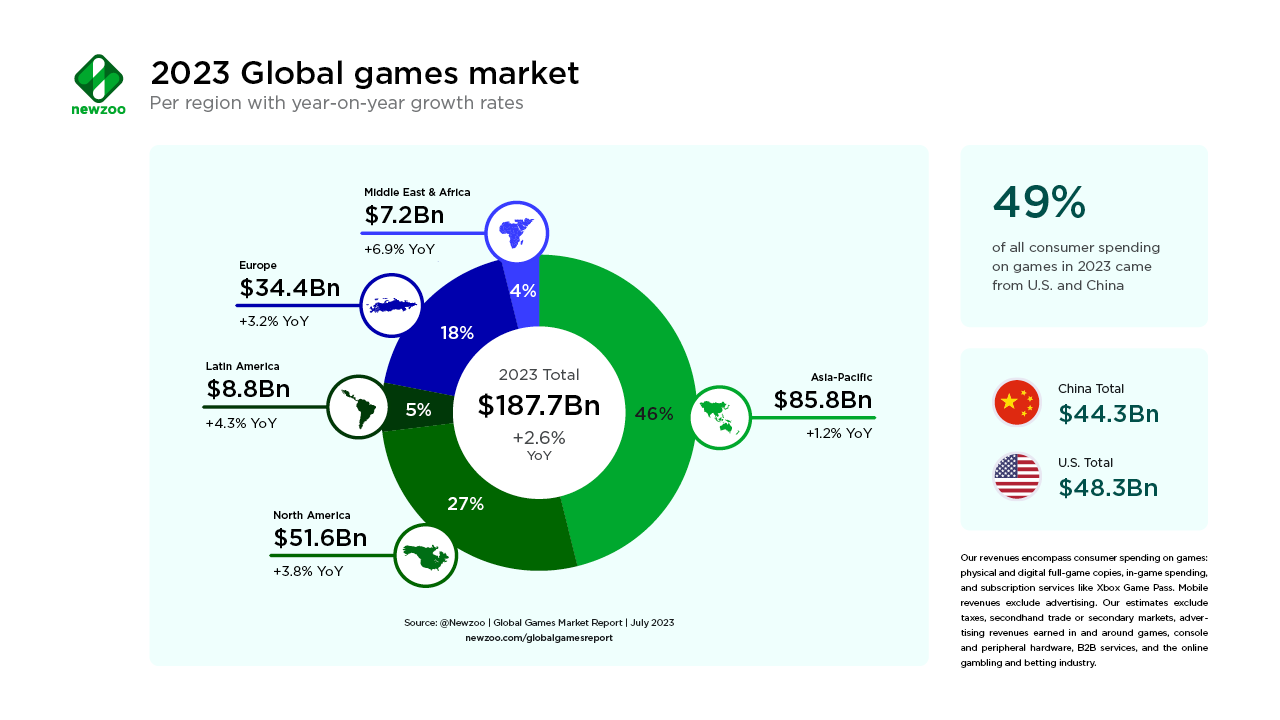
(Source: newzoo.com)
- In 2023 the mobile gaming industry is expected to account for a staggering 56% of all worldwide gaming spending of consumers. This is more than the predicted 22% for consoles, and 21% for PCs and Macs.
- It is estimated that the gaming market, valued at about 257 billion US dollars is currently in a good place. After the pandemic ended in the last few years, competition among gaming platforms and the variety of games offered was the main reason for the growth in entertainment.
- Around 3.26 billion gamers in the world are avid gamers.
- In 2022, gamers from the US paid 55.5 milliards US dollars playing video games.
- About 90% of gaming revenues come from free-to-play gaming.
- As of 2022, there will be around 90 billion downloads of mobile games available on app stores.
- In 2025, the gaming industry will be worth 46.7 milliards US dollars.
- Between 18 to 34 constitute 38% of all gamers worldwide.
- In 2025 about 85% of the revenue generated in the industry of digital games is generated by games that are free to play.
Mobile Gaming Statistics and Facts
- 90 billion games downloaded on mobile devices across both app stores by 2022 (Udonis) –Despite declining revenues in the mobile gaming industry, downloads of games had a 17.4% increase. By 2022 they surpassed close to 90 billion. This was 6 billion more than in 2021. Games that were played in a hyper-casual manner were the primary reason for downloads.
- In 2025, the mobile game business will be worth 138 billion dollars (Sensor Tower) – The above figure contains data from the industry of mobile gaming that includes Apple Store and Google Play. The popularity of gaming on mobile has increased to a large extent since the beginning of smartphones. At one time it was “Angry Birds”. Later, Pokemon GO and Fortnite became the most popular games in the world.
- The US In the US, people typically have approximately eight games installed on a computer (TechCrunch)- On an international level, gamers typically play between two and five games per month. The amount of time they play games increases by 10% annually. In 2019, mobile gaming was responsible for 10% of gamers' app spending. Video and mobile gameplay figures show that mobile games are on track to be responsible for 60% the consumer spending at the end of 2019.
- In 2020 gamers played for 4.2 hours per day playing Android game apps (App Annie) – The amount of time equates to 3.5 trillion minutes, which is up 20% from the year before. In comparison, the average person played for 3.7 hours watching television simultaneously. Despite the notion that young people are the only ones who are addicted to mobile games, it's as simple as the way. For example, In the US, Gen X or Baby Boomers spend 30% more time on the most frequently used apps. Additionally, the most popular games make up 55% of time spent playing games.
- Subway Surfers is the most popular Android game app that is played by players in The US ( Statista) – The game Subway Surfers has more than 2 million active players daily which makes it among the more “populous” gaming apps. The game is followed
- Clash of Clans – 1.94 million active players per day.
- Candy Crush Saga – 1.4 million daily active users.
- 8 Ball Pool – 1.45 million active per day users.
- Roblox – 1.14 million active daily users.
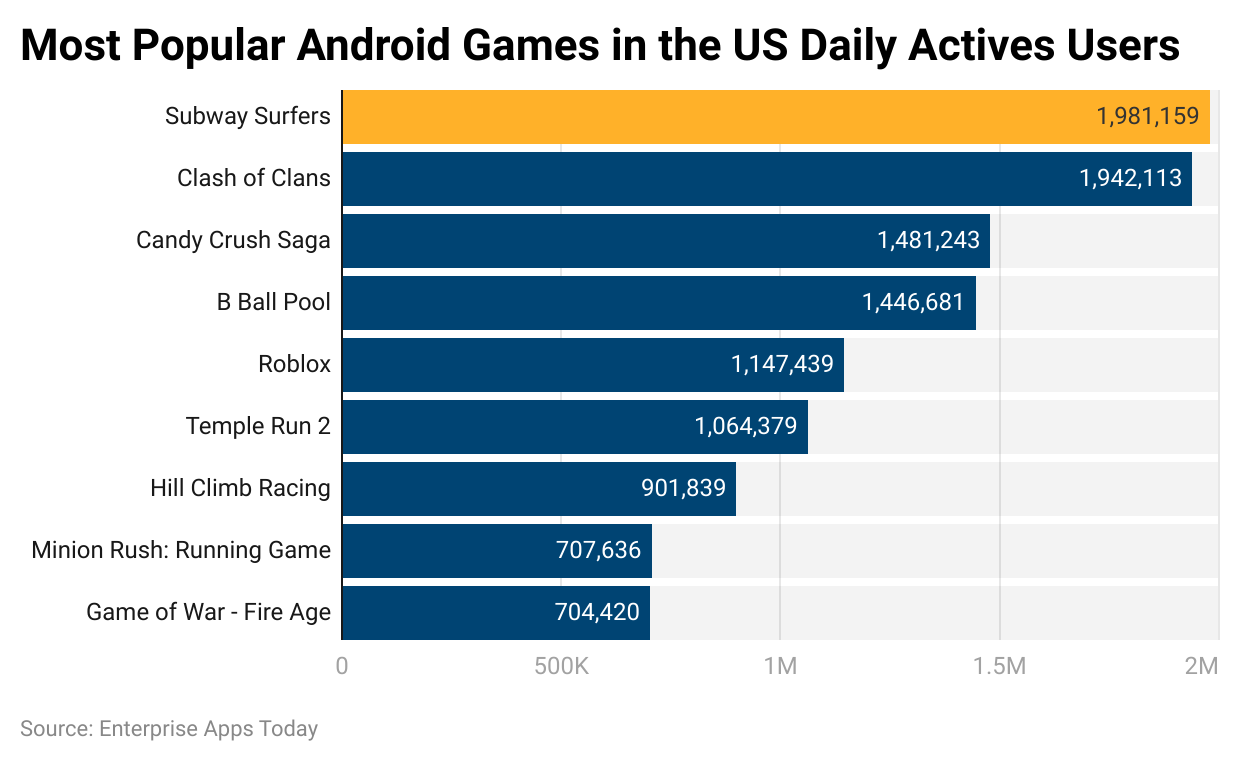
(Source: truelist.co)
- Around 74% of American gamers prefer to view games' ads when they are offered benefits (Business of Apps)-70% of Android users don't enjoy advertisements on mobile devices and in stores, however, games are a completely different story. This doesn't mean games that are free won't earn money. The majority of these games depend on in-app purchases that comprise 95% of all spending by mobile players.
Top 10 Games of 2023
- MARVEL SNAP – In-app purchases: $1.99 – $99.99 (In-game currency and cosmetics).
- Vampire Survivors – In-app purchases: $1.99 (One-time payment for DLC)
- Rocket League Sideswipe – In-app purchases: None.
- Sky: Children Of The Light – In-app purchases: $0.99 – $49.99 (In-game currency)
- Pokémon Go – In-app purchases: $0.99 – $99.99 (In-game items and cosmetics)
- My Friend Pedro: Ripe for Revenge – In-app purchases: $2.99 (One-time purchase to unlock save feature)
- AnimA ARPG(Action RPG) – In-app purchases: $0.99 – $35.99 (Cosmetics)
- Brawlhalla – In-app purchases: $5.99 – $49.99 (Cosmetics and characters)
- Another Eden- In-app purchases: $0.99 – $79.99 (In-game currency and characters)
- Call Of Duty – In-app purchases: $0.99 – $99.99
The Abstract Impacts of Mobile Games on Children
The research examined the relationship between children's gaming habits as well as online risks and their mental health. Data was gathered from a representative sample of 2,702 fourth and third graders at 16 elementary schools across Taiwan as well as 9 elementary schools across China. The findings showed that around 54% of kids played mobile games with other children (multi-player) 31% played games on mobile on their own while 15% did not participate in mobile games. Multiple logistic regression results showed that certain behaviors, such as taking part in games that involve multiple players or playing violent games, the lack of a parent-child relationship, and being in a rural location had been associated with a higher likelihood of addiction to mobile gaming.
It was reported that the American Psychiatric Association included Internet Gaming Disorders in Section III (disorders needing further study) of the Fifth Edition of the Diagnostic and Statistical Manual of Mental Disorders (DSM-5) in 2013 while the World Health Organization included Gaming Disorders in the 11th edition of the International Classification of Diseases (ICD-11) in 2018 1212. These papers utilized “internet gaming disorder,” online gambling addiction” in addition to “problem playing” in interchangeable ways.
SAS Software was employed to conduct statistics analysis. The means and percentages of all variables were calculated. A series of multiple logistic regressions were conducted to examine relationships between children's demographic background, mobile gaming preferences, and online risks (mobile gaming addiction, mobile violence/pornography exposure, and cyber aggression/victimization).
Participants in the study included 1,284 boys (47.5%) as well as 1,418 females (52.5%). The majority of the students (56.6%) resided in Taiwan as well and 1,177 (43.4%) were from China. In addition, 1,135 of them (41.9%) resided in urban areas while 1,576 (58.1%) were within rural regions. There was no difference between the rural and urban regions in Taiwan as well as in China regarding the gender or grade of students.
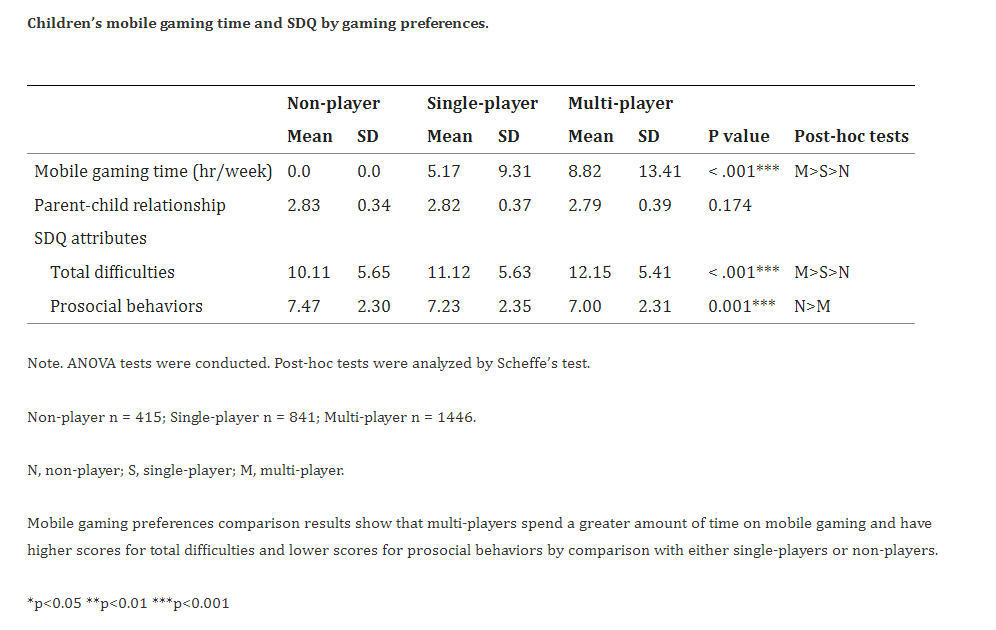
(Source: ncbi.nlm.nih.gov)
HTML0About 12.2% of children suffer from addiction to gaming on mobile devices. Furthermore, 27.4% of children had experienced violence on tablets or smartphones and 16.6%of children were exposed to pornography via tablets or smartphones. Furthermore, 10.9% of children have been victims of cyberattacks, and 4.3% reported cyber-attacks.
Conclusion
The results of this study revealed that nearly half the children in the study had played games on mobiles with others. Children who were multi-players had a higher proportion of online risk such as mobile gaming addiction and exposure to mobile violence/pornography and cyber aggression/victimization compared with single-players and non-players. In addition, children who were multi-players were more likely to have mobile gaming addictions, have mobile violence exposure, experience cyber aggression/victimization, and suffer from emotional and behavioral problems.
To conclude, players tend to be drawn towards the latest game is primarily due to their fondness for games with favorable reviews. One of the primary sources for information on games is recommendations as well as recommendations from friends and family.
FAQ.
We can expect to see an increase in the number of mobile games with console-quality graphics and gameplay, as well as the development of new genres of games that take advantage of the increased connectivity and speed offered by 5G. Overall, the future of mobile gaming looks bright for 2023 and beyond.
In 2023, the Mobile Games market is projected to generate a revenue of US$89.25bn worldwide. Looking ahead, the market is expected to exhibit a compound annual growth rate (CAGR 2023-2027) of 7.43%, resulting in a projected market volume of US$118.90bn by 2027.
Online mobile gaming industry - analysis, trends, and statistics. Gaming, and mobile gaming in particular, continued to rule the entertainment industry in 2022. Newzoo reports the global gaming market generated $184.4B in revenue, half ($92.2B) coming from mobile gaming alone in 2022.
In 2022, the top 10 markets and countries by revenues were the United States, China, Japan, South Korea, Germany, the United Kingdom, France, Canada, Italy, and Brazil. While the US topped the revenue charts with $46.6 billion, China had the highest number of players (699.6 million).
Unsurprisingly, Gametion's Ludo King is far and away the best performer on a day to day basis. While it generated 489,730 downloads on May 6th, 2022, it typically pulled in between 300,000 and 400,000 downloads per day.
Niko Partners projects India video games revenue across all platforms to reach $868 million in 2023, up 21.2% YoY. India's video game market is the fastest growing by gamers and revenue, which is forecast to reach $1.6 billion by 2027, growing at a 5-year CAGR of 17.2%.
Downloadable mobile games were first commercialised in Japan circa the launch of NTT DoCoMo's I-mode platform in 1999, and by the early 2000s were available through a variety of platforms throughout Asia, Europe, North America and ultimately most territories where modern carrier networks.
It is estimated that global mobile gaming app revenues will grow from 86.9 billion U.S. dollars in 2020 to 92.2 billion U.S. dollars in 2022. Mobile gaming is the biggest revenue segment of the worldwide gaming market

Barry is a lover of everything technology. Figuring out how the software works and creating content to shed more light on the value it offers users is his favorite pastime. When not evaluating apps or programs, he's busy trying out new healthy recipes, doing yoga, meditating, or taking nature walks with his little one.



